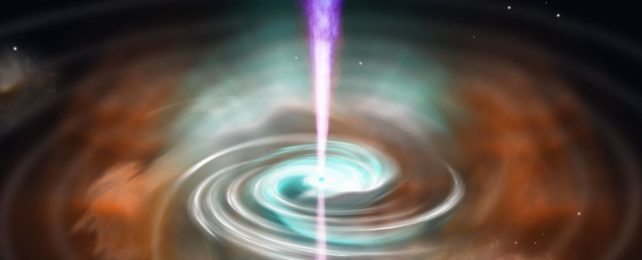A flash of light emitted by colliding neutron stars has once again upended our understanding of how the Universe works.
Analysis of the short gamma-ray burst spat out as the two stars merged revealed that, rather than forming a black hole, as expected, the immediate product of the merger was a highly magnetized neutron star far heavier than the estimated maximum neutron star mass.
This magnetar seems to have persisted for over a day before collapsing down into a black hole.
"Such a massive neutron star with a long life expectancy is not normally thought to be possible," astronomer Nuria Jordana-Mitjans of the University of Bath in the UK told The Guardian. "It is a mystery why this one was so long-lived."
Neutron stars are on a spectrum of how a star can end up at the end of its life. For millions or billions (or potentially trillions) of years, a star will chug along, an engine fusing atoms in its hot pressurized core.
Eventually, the atoms a star can fuse will run out, and at this point, everything sort of explodes. The star ejects its outer mass and, no longer supported by the outward pressure supplied by fusion, the core collapses under the inward pressure of gravity.
How we categorize these collapsed cores depends on the mass of the object. The cores of stars that started out up to around 8 times the mass of the Sun collapse down into white dwarfs, which have an upper mass limit of 1.4 solar masses, squished into a sphere around the size of Earth.
The cores of stars between 8 and 30 solar masses turn into neutron stars, between around 1.1 and 2.3 solar masses, in a sphere just 20 kilometers (12 miles) across. And the biggest stars, over the neutron star upper mass limit, collapse into black holes, according to theory.
But there's a very notable dearth of black holes below 5 solar masses, so what happens in that mass regime is largely a mystery.
This is why neutron star mergers are so interesting to astronomers. They come about when two neutron stars are in a binary system and have reached the point of orbital decay at which they inevitably smoosh together and become one object combining the two neutron stars.
Most binary neutron stars have a combined mass that exceeds the theoretical upper mass limit for neutron stars. So the products of these mergers are likely to sit solidly within that neutron star-black hole mass gap.
When they collide, binary neutron stars release a burst of high-energy radiation known as a short-duration gamma-ray burst. Scientists had thought that these could only be emitted during the formation of a black hole.
But exactly how the merging neutron stars turn into a black hole has been something of a puzzle. Does the black hole form instantaneously, or do the two neutron stars produce a very heavy neutron star that then collapses into a black hole very quickly, no more than a few hundred milliseconds after the merger?
GRB 180618A was a short-duration gamma-ray burst detected in June 2018, light that had traveled 10.6 billion years to reach us. Jordana-Mitjans and her colleagues wanted to take a closer look at the light emitted by this object: the burst itself, the kilonova explosion, and the longer-lived afterglow.
But, when they looked at the electromagnetic radiation produced by the event over time, something was off.
The afterglow's optical emission disappeared 35 minutes after the gamma-ray burst. This, the team found, was because it was expanding at close to light speed, accelerated by a continuous energy source.
This was consistent not with a black hole, but with a neutron star. And not just any neutron star. It seemed to be what we call a magnetar: one with a magnetic field 1,000 times more powerful than an ordinary neutron star's, and a quadrillion times more powerful than Earth's. And it hung around for over 100,000 seconds (nearly 28 hours).
"For the first time," Jordana-Mitjans says, "our observations highlight multiple signals from a surviving neutron star that lived for at least one day after the death of the original neutron star binary."
What could have helped the magnetar live this long isn't clear. It's possible that the magnetic field gave it a little help, providing an outward pull that prevented it from collapsing all the way, at least for a little while.
Whatever the mechanism was – and this is definitely going to warrant some further investigation – the team's work shows that supramassive neutron stars are capable of launching short-duration gamma-ray bursts, and that we can no longer assume the presence of a black hole.
"Such findings are important as they confirm that newborn neutron stars can power some short-duration GRBs and the bright emissions across the electromagnetic spectrum that have been detected accompanying them," Jordana-Mitjans says.
"This discovery may offer a new way to locate neutron star mergers, and thus gravitational waves emitters, when we're searching the skies for signals."
The research has been published in The Astrophysical Journal.
